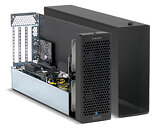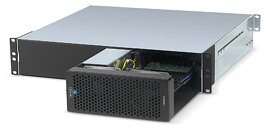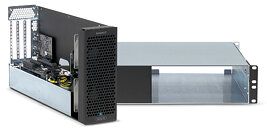Sonnet Technologies today announced the launch of the Echo III Desktop and Echo III Rackmount, the newest members of the company's award-winning family of Thunderbolt 3 to PCI Express (PCIe ) card expansion systems. The Echo III Desktop is a full-size desktop chassis that enables the use of up to three high-performance PCIe cards with computers equipped with Thunderbolt ports, while the Echo III Rackmount offers the same support and features in a rack-mountable 2U enclosure. Replacing the popular Echo Express III-D and III-R (including HDX Editions), the new Echo systems have been upgraded with the addition of a mode switch that enables the use of multiple Avid Pro Tools|HDX PCIe cards and new cooling fans for even quieter operation. Both of these units have been Avid-qualified.



What They Do:
Echo III Desktop and Rackmount expansion systems enable users to connect three PCIe cards to computers lacking PCIe card slots. The Echo III Module used in both systems features one x16 and two x8 PCIe 3.0 slots; accommodates up to full-height, full-length (up to 12.28 inches long) PCIe cards; and connects them to a computer's Thunderbolt port via the included 0.7-meter Thunderbolt 3 (40 Gbps) cable. The module integrates a universal 400 W power supply and includes a 75 W auxiliary power connector for non-GPU cards that require extra power. The Echo III Module provides two Thunderbolt 3 ports, with one for connection to the computer, while the second supports daisy-chaining of up to five additional Thunderbolt peripheral devices plus two 4K monitors (or one 5K display), or a single USB device. The system provides up to 15 W of power to any connected peripheral or host.
Why They're Important:
In general, computers lack the unique ports and specific data processing capabilities needed for pro audio and video workflows, forcing users to add internal or external interfaces to support I/O, audio digital signal processing, and video capture and playback. While desktop workstations, like the Mac Pro, can be outfitted with PCIe adapter cards to add what's needed, the portable, mini desktop, and all-in-one computers (such as the MacBook Pro, Mac mini, and iMac ) often favored by pro users require the use of Thunderbolt-connected expansion. Sonnet's Echo III Desktop and Echo III Rackmount expansion systems enable users to save space and money by mounting up to three PCIe cards in a transportable desktop or 2U rackmount enclosure, respectively, and connecting them to their computer through a single Thunderbolt 3 cable.
How They're Unique:
With the inclusion of Sonnet's unique HDX mode switch, Pro Tools users can install up to three HDX PCIe cards into the Echo III Desktop or Echo III Rackmount without the additional parts or adapters previously needed to enable their use. Echo III expansion systems feature dual Noctua NF-R8 redux-1800 fans, known for their low-noise operation, making the Sonnet chassis more suitable for use in noise-sensitive environments. Sonnet designed Echo III expansion systems with flexibility in mind — not only are the systems available in two form factors, but Sonnet will also offer desktop and rackmount enclosures for purchase separately, enabling users to move one Echo III module (with PCIe cards installed) between enclosures. Additionally, the Echo III Rackmount has mounting space for another Echo III Module (also available separately) or for future expansion modules coming soon.
When You Can Get Them:
TThe Echo III Desktop (part number ECHO-3D-T3) and Echo III Rackmount (part number ECHO-3R-T3) will be available from Sonnet on December 11 at suggested retail prices of 799.99 USD and 899.99 USD, respectively.
View at TechPowerUp Main Site



What They Do:
Echo III Desktop and Rackmount expansion systems enable users to connect three PCIe cards to computers lacking PCIe card slots. The Echo III Module used in both systems features one x16 and two x8 PCIe 3.0 slots; accommodates up to full-height, full-length (up to 12.28 inches long) PCIe cards; and connects them to a computer's Thunderbolt port via the included 0.7-meter Thunderbolt 3 (40 Gbps) cable. The module integrates a universal 400 W power supply and includes a 75 W auxiliary power connector for non-GPU cards that require extra power. The Echo III Module provides two Thunderbolt 3 ports, with one for connection to the computer, while the second supports daisy-chaining of up to five additional Thunderbolt peripheral devices plus two 4K monitors (or one 5K display), or a single USB device. The system provides up to 15 W of power to any connected peripheral or host.
Why They're Important:
In general, computers lack the unique ports and specific data processing capabilities needed for pro audio and video workflows, forcing users to add internal or external interfaces to support I/O, audio digital signal processing, and video capture and playback. While desktop workstations, like the Mac Pro, can be outfitted with PCIe adapter cards to add what's needed, the portable, mini desktop, and all-in-one computers (such as the MacBook Pro, Mac mini, and iMac ) often favored by pro users require the use of Thunderbolt-connected expansion. Sonnet's Echo III Desktop and Echo III Rackmount expansion systems enable users to save space and money by mounting up to three PCIe cards in a transportable desktop or 2U rackmount enclosure, respectively, and connecting them to their computer through a single Thunderbolt 3 cable.
How They're Unique:
With the inclusion of Sonnet's unique HDX mode switch, Pro Tools users can install up to three HDX PCIe cards into the Echo III Desktop or Echo III Rackmount without the additional parts or adapters previously needed to enable their use. Echo III expansion systems feature dual Noctua NF-R8 redux-1800 fans, known for their low-noise operation, making the Sonnet chassis more suitable for use in noise-sensitive environments. Sonnet designed Echo III expansion systems with flexibility in mind — not only are the systems available in two form factors, but Sonnet will also offer desktop and rackmount enclosures for purchase separately, enabling users to move one Echo III module (with PCIe cards installed) between enclosures. Additionally, the Echo III Rackmount has mounting space for another Echo III Module (also available separately) or for future expansion modules coming soon.
When You Can Get Them:
TThe Echo III Desktop (part number ECHO-3D-T3) and Echo III Rackmount (part number ECHO-3R-T3) will be available from Sonnet on December 11 at suggested retail prices of 799.99 USD and 899.99 USD, respectively.
View at TechPowerUp Main Site



